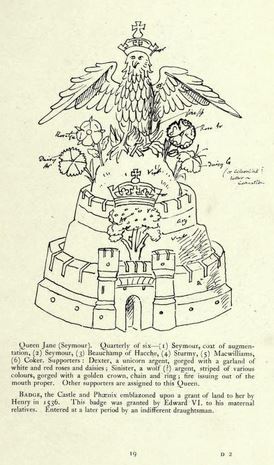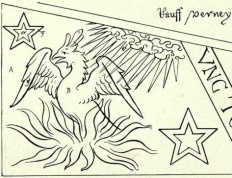Phoenix: Difference between revisions
Muirenn-ruad (talk | contribs) (Imported from Wikispaces) |
|||
| Line 7: | Line 7: | ||
===Peacock-like, pheasant-like:=== | ===Peacock-like, pheasant-like:=== | ||
{| | {| | ||
| | | https://scontent-ord1-1.xx.fbcdn.net/hphotos-xaf1/v/t1.0-9/11350636_10205090975168412_2687519818713025322_n.jpg?oh=0eb5263336b0ee1487f0006af0f9294d&oe=5601059E|235x230px|Italian]] | ||
| https://scontent-ord1-1.xx.fbcdn.net/hphotos-xfa1/v/t1.0-9/10383901_10205090977768477_6090717296902671278_n.jpg?oh=15b60f8e3f94a92a747c131449e0885a&oe=56026D22|248x384px|Worshipful]] | |||
|- | |- | ||
|===Tudor Badges and Banners:=== | | Italian Commemorative Medal, mid-15th century, by Bartolo talpas? peacock-like phoenix | ||
| | | Worshipful Company of Painter-Stainers, courtesy of Bruce Draconarius | ||
| [[File:TudorBanner_phoenix-castle.jpg|Banners,]] | |} | ||
===Tudor Badges and Banners:=== | |||
{| | |||
| [[File:TudorBanner_phoenix-castle.jpg|Banners,]] | |||
| [[File:TudorBanner_phoenix-sunburst.jpg|233x178px|Banners,]] || | |||
|- | |- | ||
| | | "Banners, Standards and Badges from a Tudor manuscript in the College of Arms", Jane Seymour badge with castle and odd phoenix with feet | ||
| "Banners, Standards and Badges from a Tudor manuscript in the College of Arms", p 138, banner with phoenix, sunburst, fimbriated/pierced mullets | |||
|} | |} | ||
From Parker: The badge of Jane Seymour, third queen of Henry VIII., blazoned upon a grant of lands made to her in 1536... The walls argent, the ground vert, the tree of the same fructed gules, the phœnix or, in flames proper, and the roses alternately white and red. | |||
==Modern:== | ==Modern:== | ||
Revision as of 08:01, 2 September 2018
WARNING: Do not cite this page as a reference. This page is on this wikispace only to make the content "searchable" and easier to find. If you find the information you seek here, go to the original sources as linked below to verify the information and use them for your documentation. Revised {$revisiondate}.
Illustrations:
Period:
Peacock-like, pheasant-like:
| 235x230px|Italian]] | 248x384px|Worshipful]] |
| Italian Commemorative Medal, mid-15th century, by Bartolo talpas? peacock-like phoenix | Worshipful Company of Painter-Stainers, courtesy of Bruce Draconarius |
Tudor Badges and Banners:
From Parker: The badge of Jane Seymour, third queen of Henry VIII., blazoned upon a grant of lands made to her in 1536... The walls argent, the ground vert, the tree of the same fructed gules, the phœnix or, in flames proper, and the roses alternately white and red.
Modern:
Pictorial Dictionary, 3rd edition:
- [[1]]
Vector Graphics:
- Viking Answer Lady - http://www.vikinganswerlady.com/Stars/Heraldry_SVG_Images/index.htm
Brickbat's Armorial Stash
- [[2]]:
Pennsic Traceable Art Project
Sources:
Academy of St. Gabriel "Medieval Heraldry Archive" - http://www.s-gabriel.org/heraldry/ Archive of St. Gabriel reports - [[3]] Laurel Armory Articles - http://heraldry.sca.org/laurel/armory_articles.html
New Heraldic Primer (Heraldry for Non-Heralds) - http://heraldry.sca.org/armory/newprimer/ Pictorial Dictionary of Heraldry (PicDic), 3rd Edition - @http://mistholme.com/pictorial-dictionary-of-heraldry (in progress) Period Armorials
Parker's Heraldry - http://karlwilcox.com/parker/ Riestap's Armorial Général - //http:''www.euraldic.com/lasu/bl/bl_a_aa.html
Precedents:
Precedents of the SCA College of Arms - [[4]] Morsulus Heralds Website - [[5]] (to search the LoARs and Precedents) Restatement Wiki - [[6]] (restatements of Precedents) Use the above links to be sure any precedents listed below haven't been superseded by newer precedents.
#x--Precedents:-Definition:Definition:
July 1997 LoAR:
Uggedei Mighan Nidun. Badge. (Fieldless) An oriental phoenix rising, wings displayed and tail pavonated, maintaining in its talons a sprig of basil, gules.This badge had several problems. While blazoned as an oriental phoenix, it is quite similar to a Russian Firebird, and we would have no problem with reblazoning it as one. However, the bird was not in any blazonable position. Please advise the submitter when resubmitting to be avoid conflicting with John Milton (important nonSCA arms) Argent a doubleheaded eagle displayed gules.//, and Brandenberg, //Argent, an eagle displayed gules, crowned Or. (07/1997) http://heraldry.sca.org/precedents/jaelleret.html
October 1992 LoAR:
[A phoenix gules, enflamed proper//] The phoenix was blazoned on the LOI as proper, with the 12th Century Cambridge Bestiary cited as the authority (via Dennys' [Imagination]). While the Bestiary describes the phoenix as "reddish purple," I would hesitate to define that as its heraldically proper tincture. As it turns out, there's at least one period heraldic example of a //phoenix proper//: the crest of the Worshipful Company of Painters, granted 1486, is blazoned a //Fenyx in his propre nature and coloure//. That phoenix is colored mostly gold, with red highlights and details. (Bromley & Child, Armorial Bearings of the Guilds of London, p.184 and plate 39) (Astrid of Flanders, October, 1992, pg. 1) http://heraldry.sca.org/precedents/bruce/proper.html
July 1981 LoAR:
A phoenix is defined as an eagle rising displayed out of flames. WVS [48] [LoAR 29 Jul 81], p. 13 http://heraldry.sca.org/precedents/wilhelm/otoz.html#phoenix
August 1980 LoAR:
A phoenix is an eagle rising from flames. The flames need not be specified because if they weren't there it would be an eagle instead of a phoenix. WVS [23] [LoAR 27 Aug 80], p. 2 http://heraldry.sca.org/precedents/wilhelm/otoz.html#phoenix
June 1979 LoAR:
"Proper" for a phoenix is the same as for flames of fire. (KFW, 30 Jun 79 [25], p. 24) http://heraldry.sca.org/precedents/karina/ptoz.html#phoenix
#x--Precedents:-Registerability:Registerability:
(Restricted, Reserved, SFPP, OOP)
#x--Precedents:-Conflict:Conflict:
September 1997 LoAR:
[a phoenix argent rising from flames //proper vs a //phoenix argent] This is clear [with a CD] for changing the tincture of the flames from argent to proper. Just as we will give a CD for changing the tincture of the wings on a winged monster, so do we give one for changing the tincture of the flames of a phoenix. (Aoife nic Gillechomhghain, 9/97 p. 4) http://heraldry.sca.org/precedents/jaeprec.html
September 1996 LoAR:
Colin Tyndall de ffrayser. Device. Gules, a phoenix within a double tressure Or. "This is being returned for a redraw. The tressure is far too thin, too thin for an instruction to the submitter to redraw the tressure. A possible conflict was called with Bogdan Borodets (SCA), Gules, a Russian firebird displayed Or, crested and its six tail-feathers each charged with a heart, all azure. Since this was returned for a redraw, that issue was not addressed." (09/1996) http://heraldry.sca.org/precedents/jaelleret.html
#x--Precedents:-Identifiability:Identifiability:
May 2015 LoAR: The flames of a phoenix must have contrast with the field. #131Kingeslake, College of. Device. Quarterly argent and Or, a phoenix gules rising from flames proper within a laurel wreath gules. This device must be returned for a contrast issue. Flames proper, as correctly depicted here, show alternating tongues of Or and gules. Therefore a significant proportion of the flames lie on and have no contrast with an Or quarter of the field. This problem could be solved by either changing the tincture of the flames or by changing the tincture of the field.
Name "Phoenix":
From Pelican: No More SCA-Compatibility
On the May 2008 Cover Letter, we ruled: > Therefore, as of the May 2009 decisions meetings, we declare that no new name elements or name patterns will be ruled SCA-compatible, that all names previously ruled SCA-compatible are no longer SCA-compatible and that in order for them to be registered, documentation meeting the same standards as for non-SCA-compatible names will be required. This ruling went into effect with this, the May 2009 Pelican meeting. [[7]]
Compiled Name Precedents:
[[8]]
| Elsbeth Anne Roth | 2000.03 | Precedence bars the use of Phoenix// in English in SCA group names. The return of the name //Coombe Phoenix// (March 1998) says -- The evidence that medieval English people were familiar with the legendary phoenix is not relevant unless one can demonstrate a pattern that they named places after legendary monsters. There are cultures where such a pattern might be demonstrated – Germany seems to be fairly prone to such things – but not for England...Therefore, barring evidence that Phoenix was used in English place-names, or at least that mythological animals were used, it cannot be used in English in SCA group names. [Phoenix River, Shire of, 03/00, R-Meridies] |
| Jaelle of Armida | 1998.03 | [Coombe Phoenix, Shire of] This is being returned for non-period construction. The use of coombe// in otherwise-English place names is acceptable, since it is found in such names as Combwich, Combwell, Comhampton, Compton, Combrook, and presumably Coombe Hill, assuming that this isn't a reanalysis of some other element; all of which refer to the second element as being situated in a coombe. The use of coombe with an ownership element (indicating either the family owning it, or a nearby town it is associated with) can have the element follow or precede, as in: Combe Raleigh, Combe Hay, Combe Royal -- all of which have the owner following; or Abbas Combe, English Combe (from a personal name, not the adjective "English", according to Ekwall), Castle Combe -- with the owner preceding. We presume that the //Coombe Fishacre// in Devonshire is associated with the town of Fishacre, also in that shire (see Reaney & Wilson's entry for Fishacre). //Combeinteignhead, as Ekwall notes, is simply identifying the location of this particular coombe (in Tenhide). |
| There are actually very few examples where an ordinary adjective or noun is used to modify coombe -- Ekwall's North Coombe// and //South Coombe// fall in this category, and perhaps //Castle Coombe//, depending on how one interprets it. But these all have the modifier first and the modifiers are quite ordinary topography-related terms. Based on these patterns, //Coombe Phoenix// would be plausible as a period English placename only if //Phoenix// were either a period English family name, the name of an existing town, village, or structure, or a period English topographic term. The evidence that medieval English people were familiar with the legendary phoenix is not relevant unless one can demonstrate a pattern that they named places after legendary monsters. There are cultures where such a pattern might be demonstrated -- Germany seems to be fairly prone to such things -- but not for England. The example of //Compton Scorpion// is not an example of this, but rather an example of the habit of re-interpreting unfamiliar archaic name elements. Ekwall shows period citations of this place name as //Compton Scorfen// 1279, //Compton Scorefen// 1316. (Unfortunately Speed's 1611 atlas fails to provide an end-of-period example, unless the location is identical with his //Fenny Compton//.) The name has nothing to do with scorpions and very much to do with boggy ground. Therefore, barring evidence that //Phoenix was used in English place-names, or at least that mythological animals were used, it cannot be used in English in SCA group names. (Jaelle of Armida, LoAR March 1998) |
The [[9]]:
Created {$creationdate}

